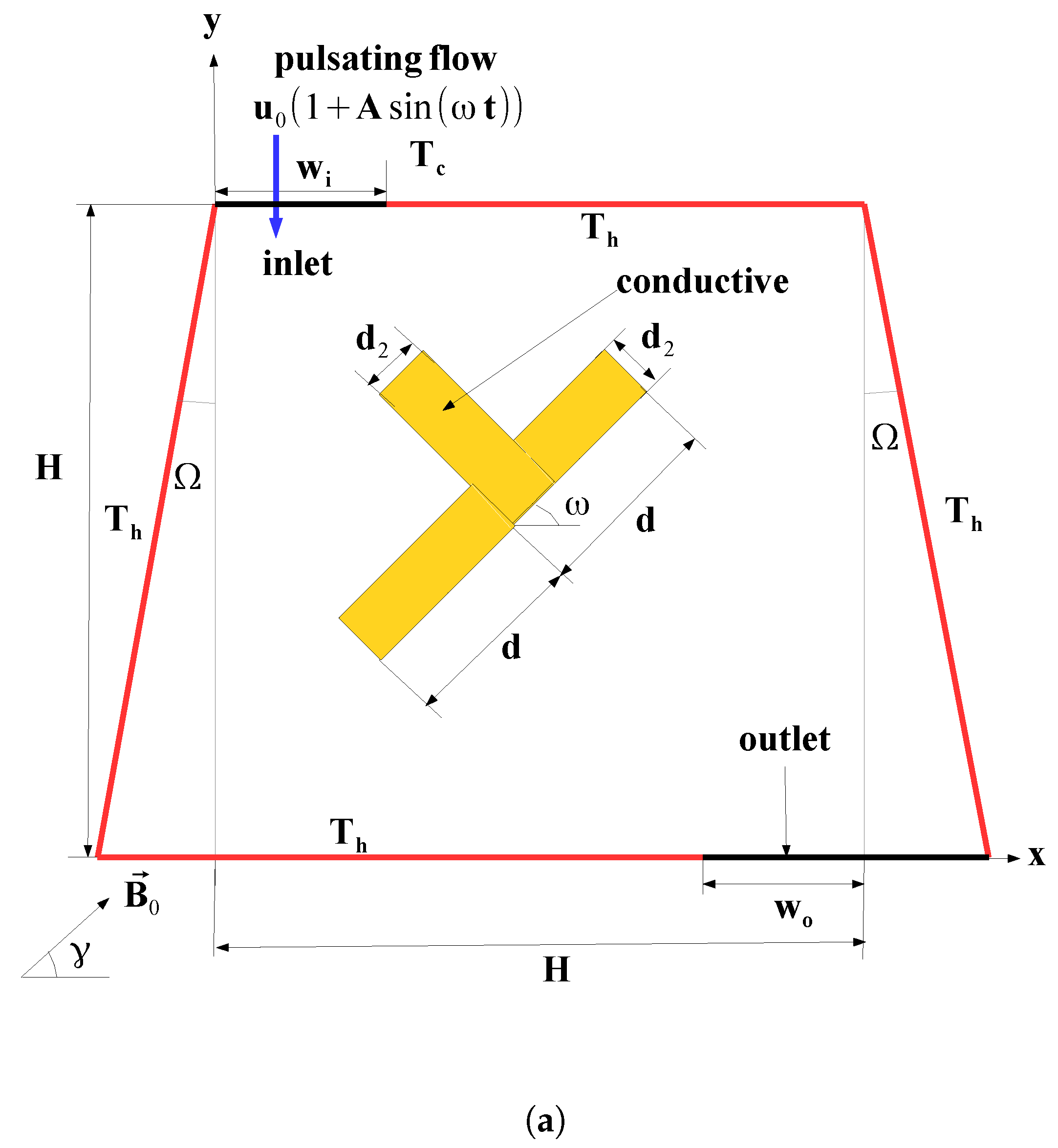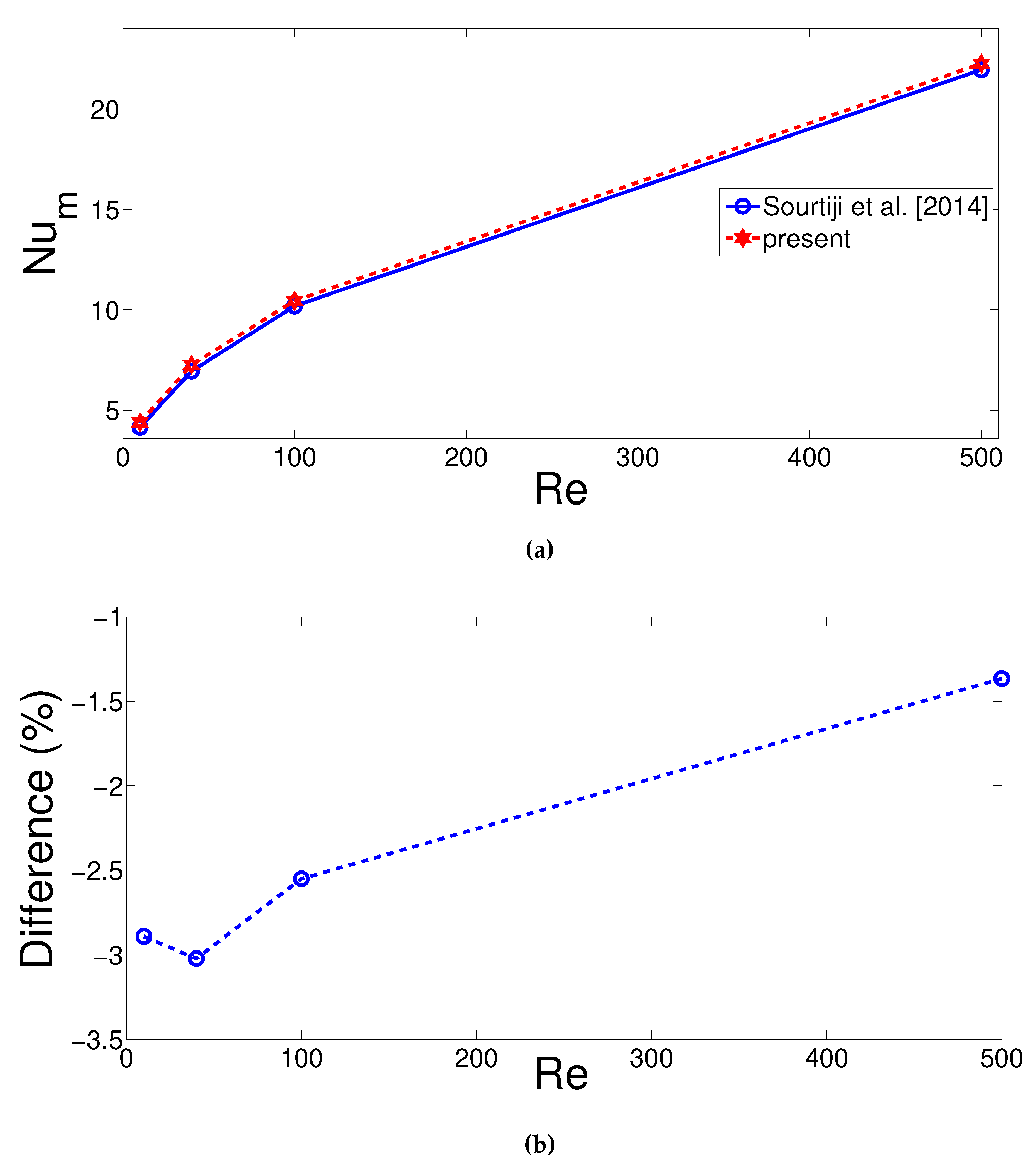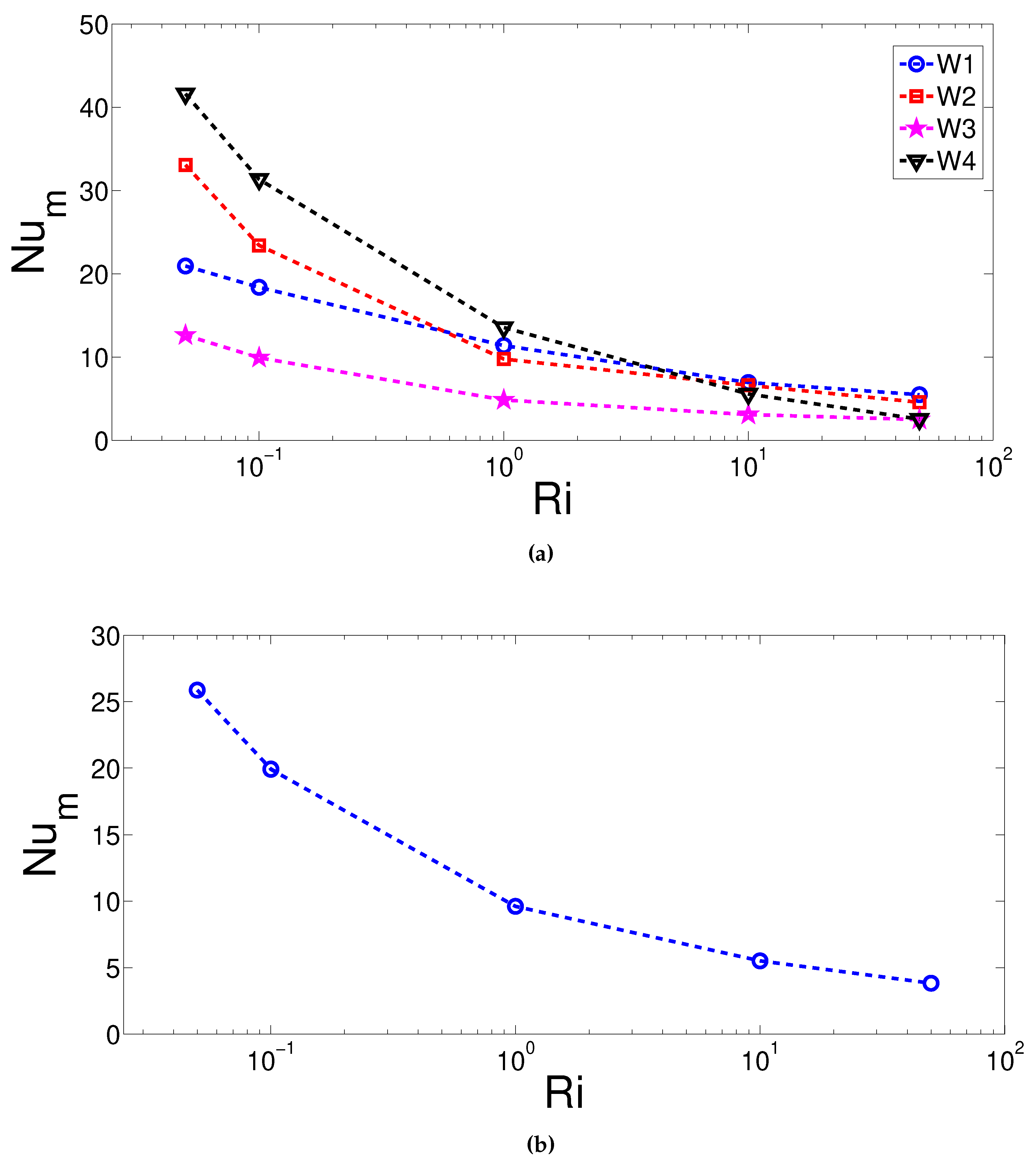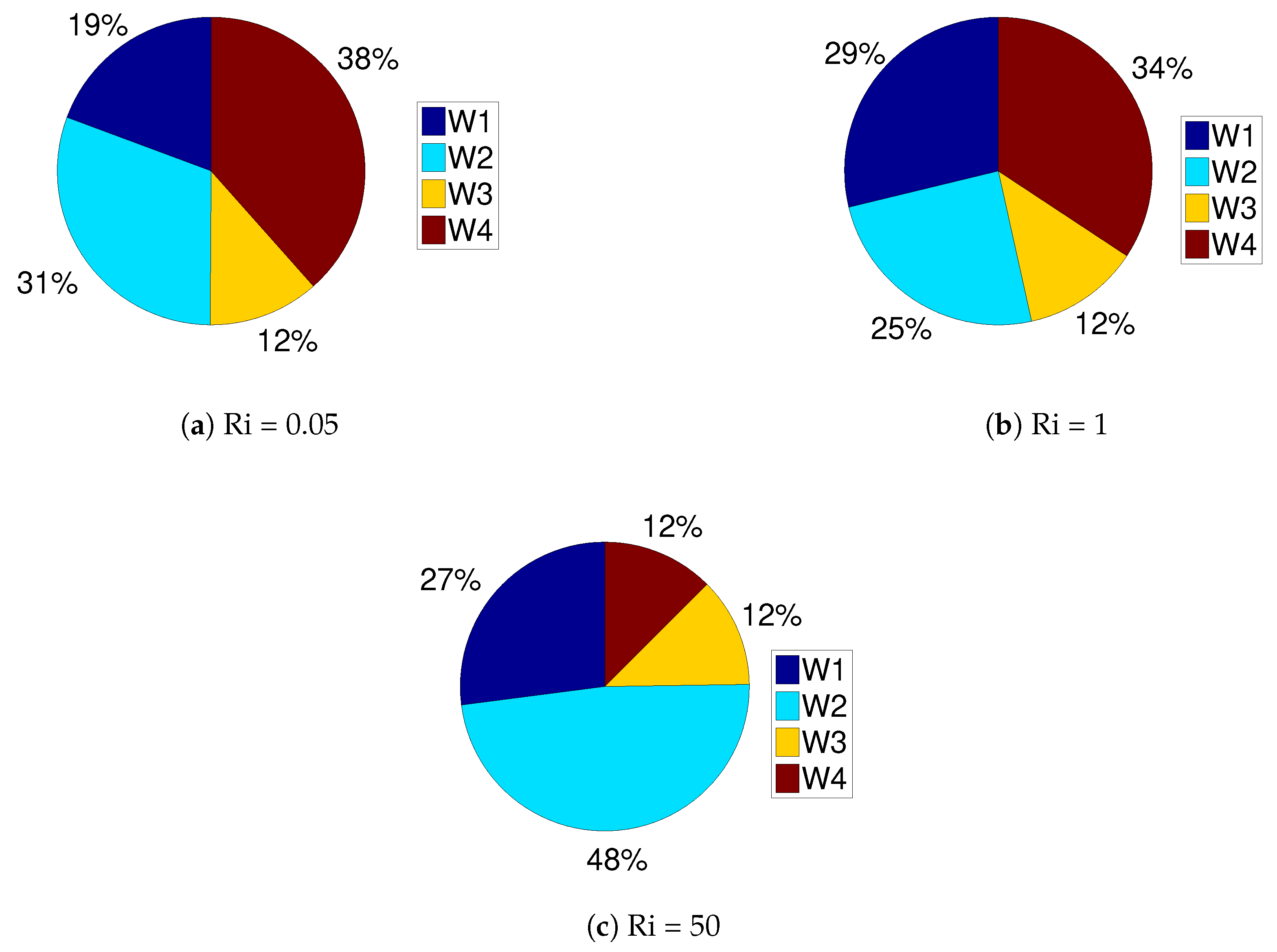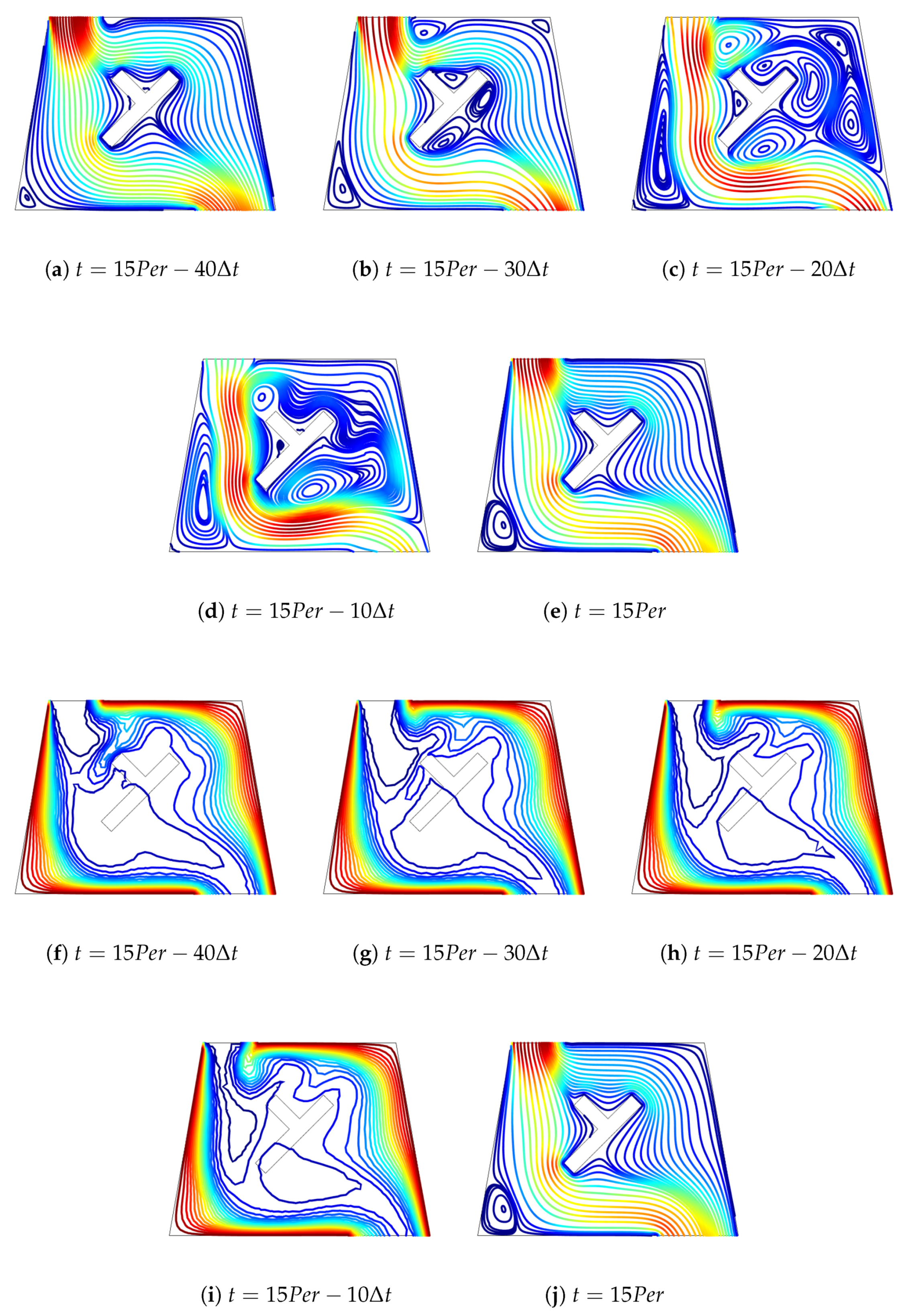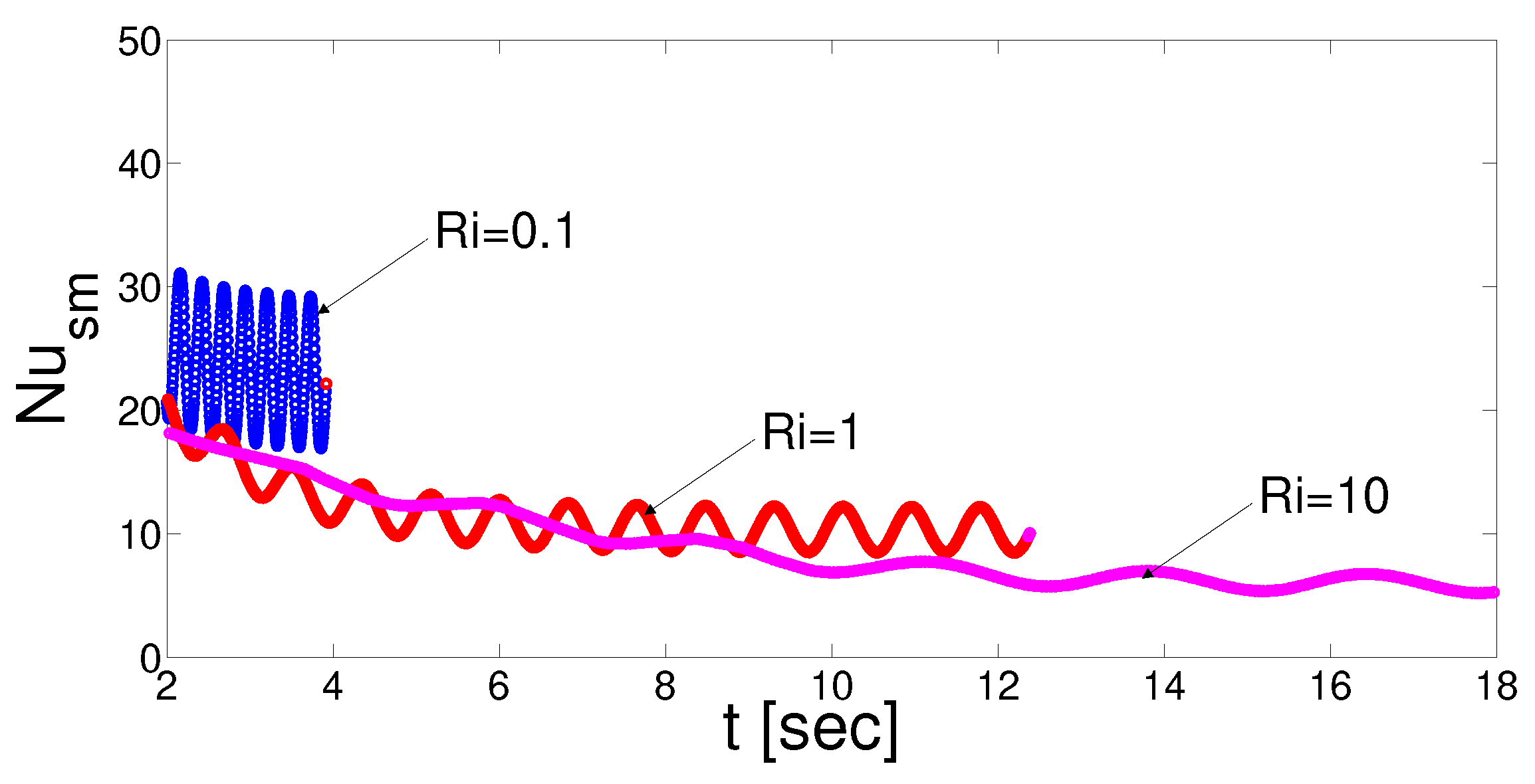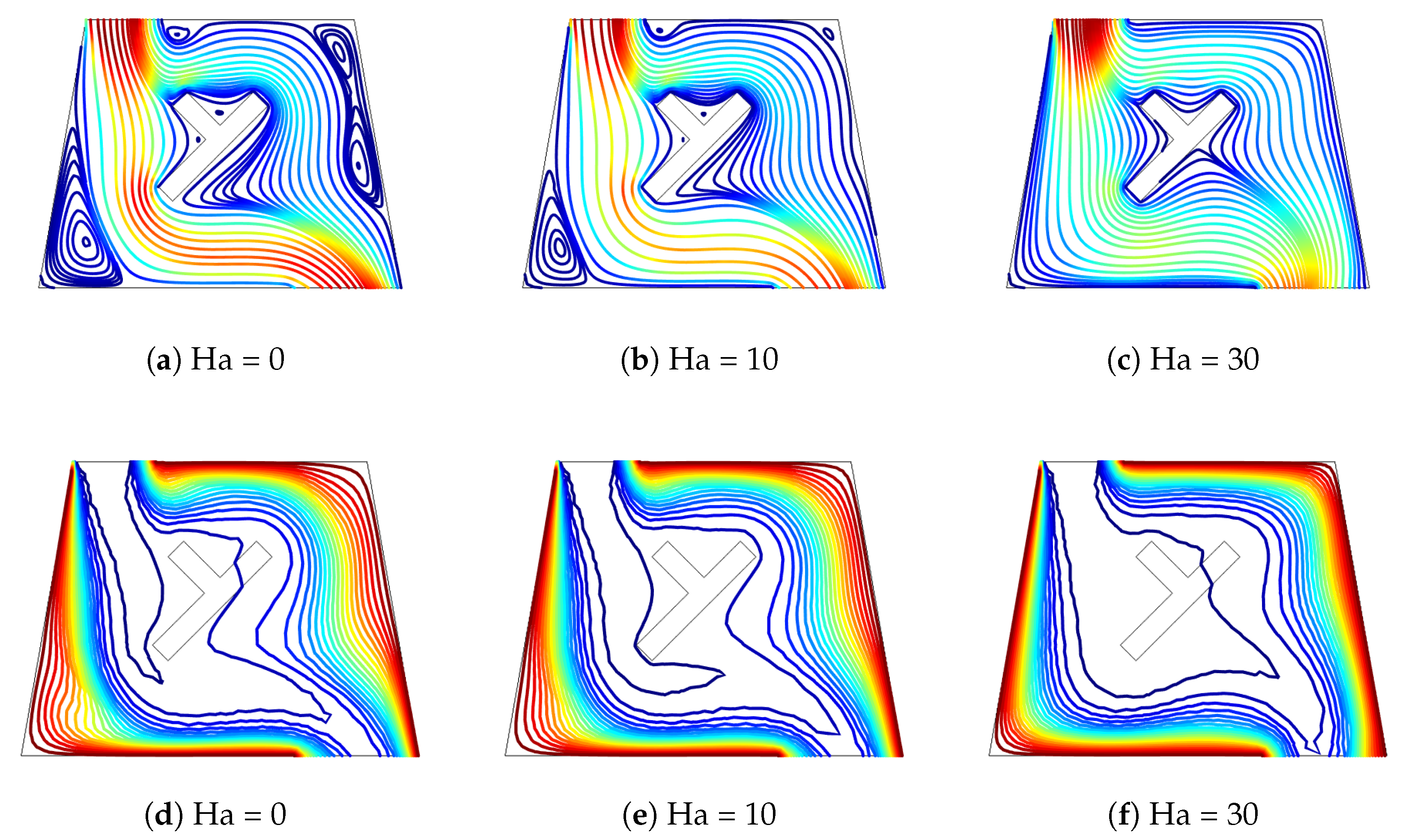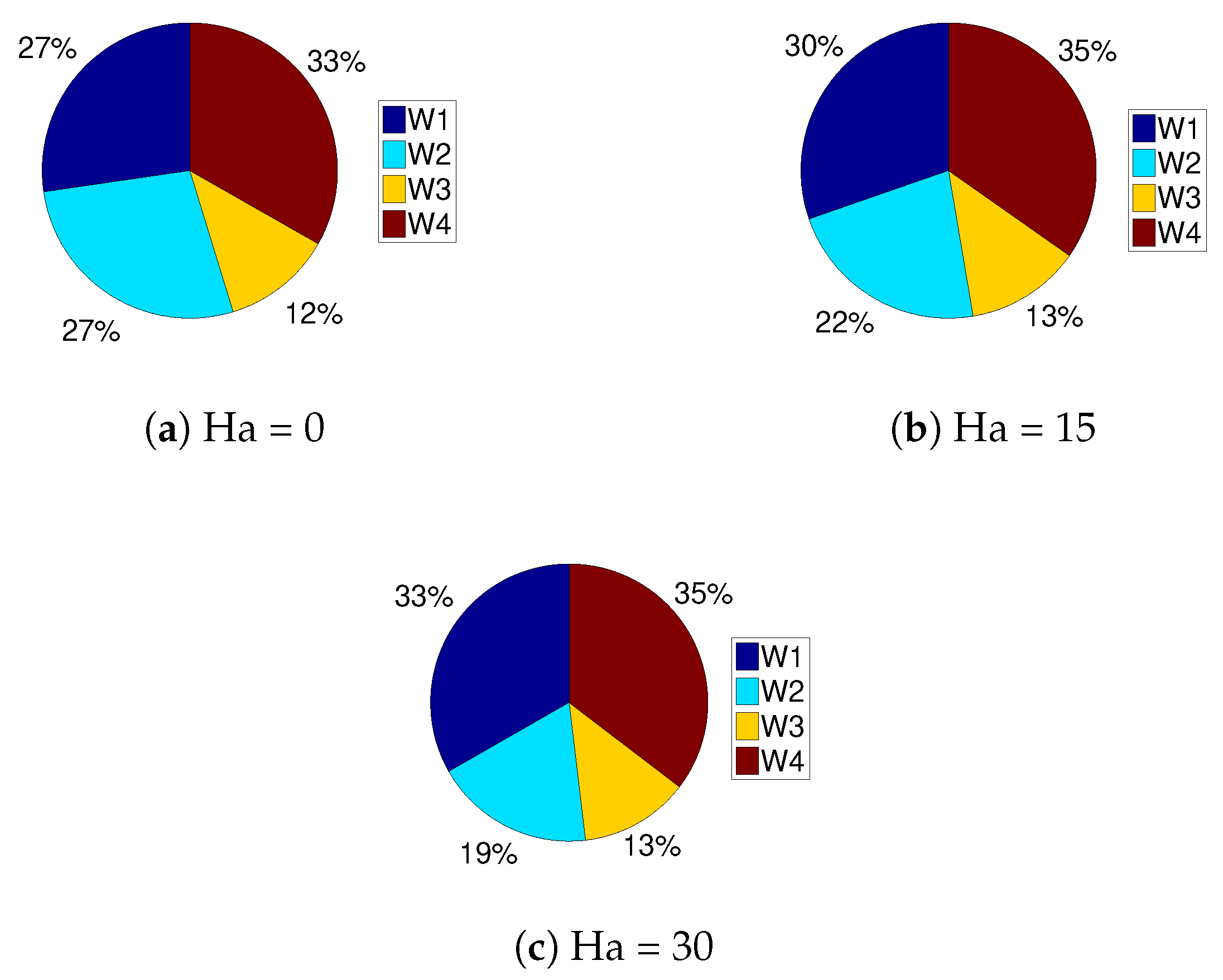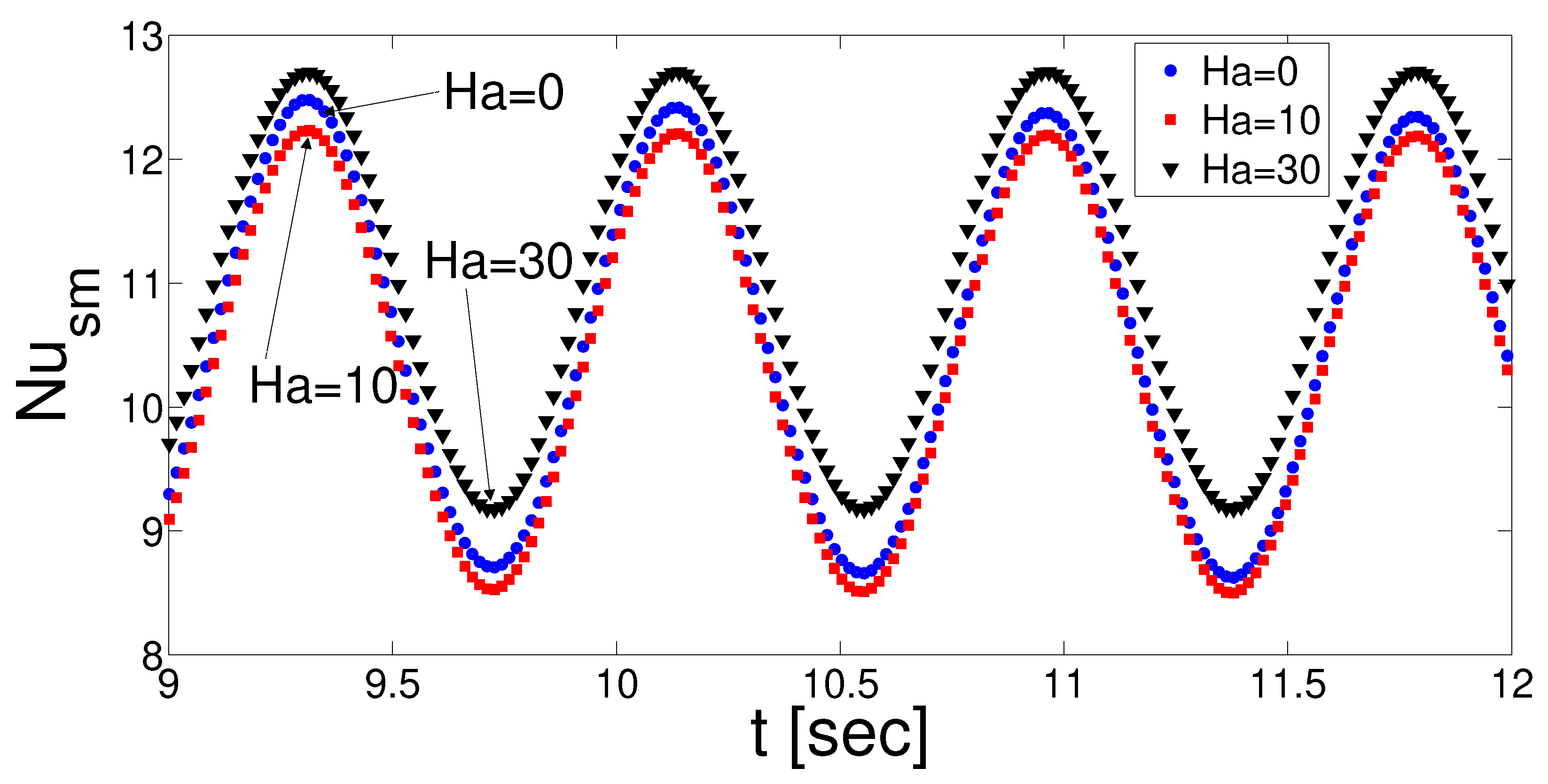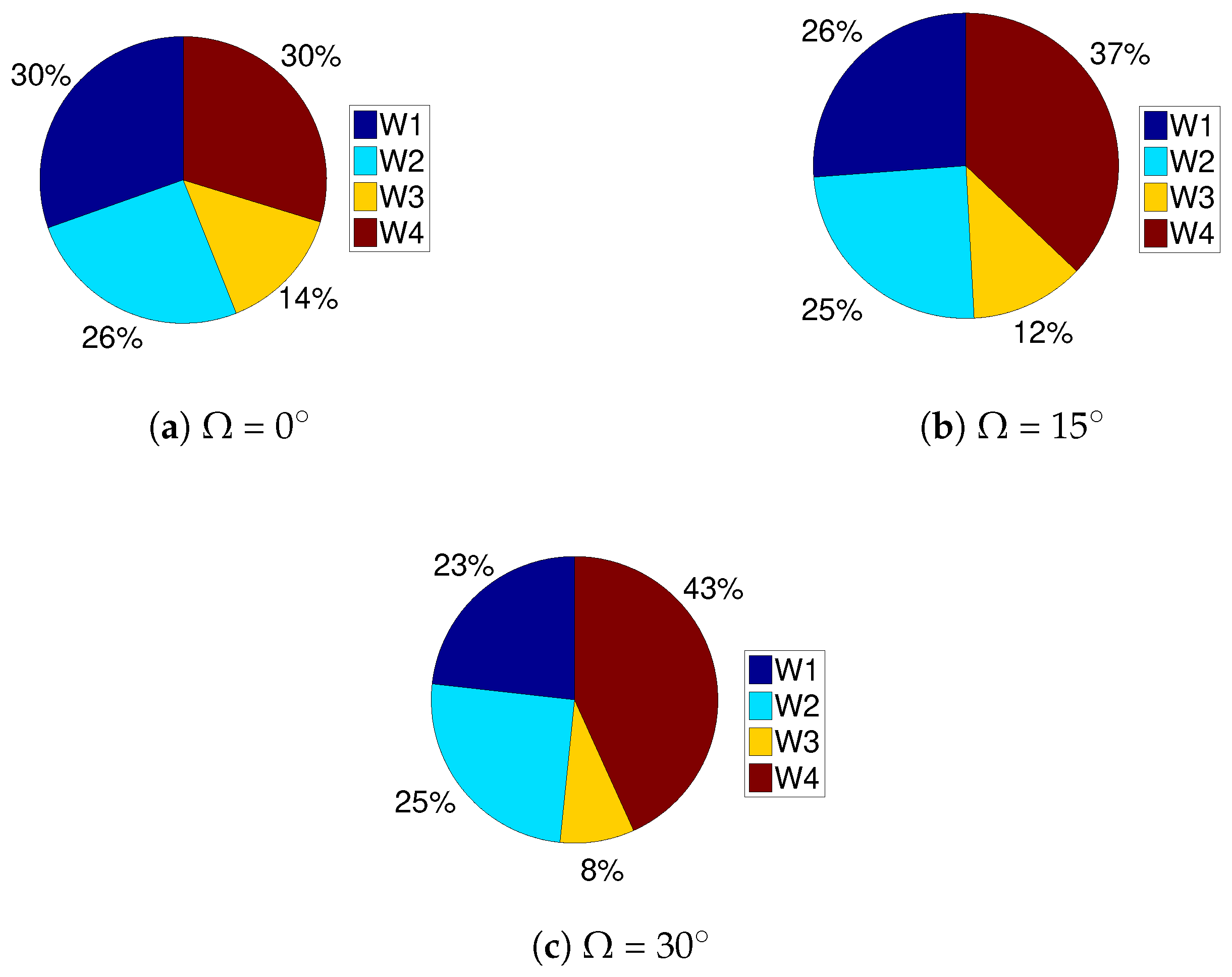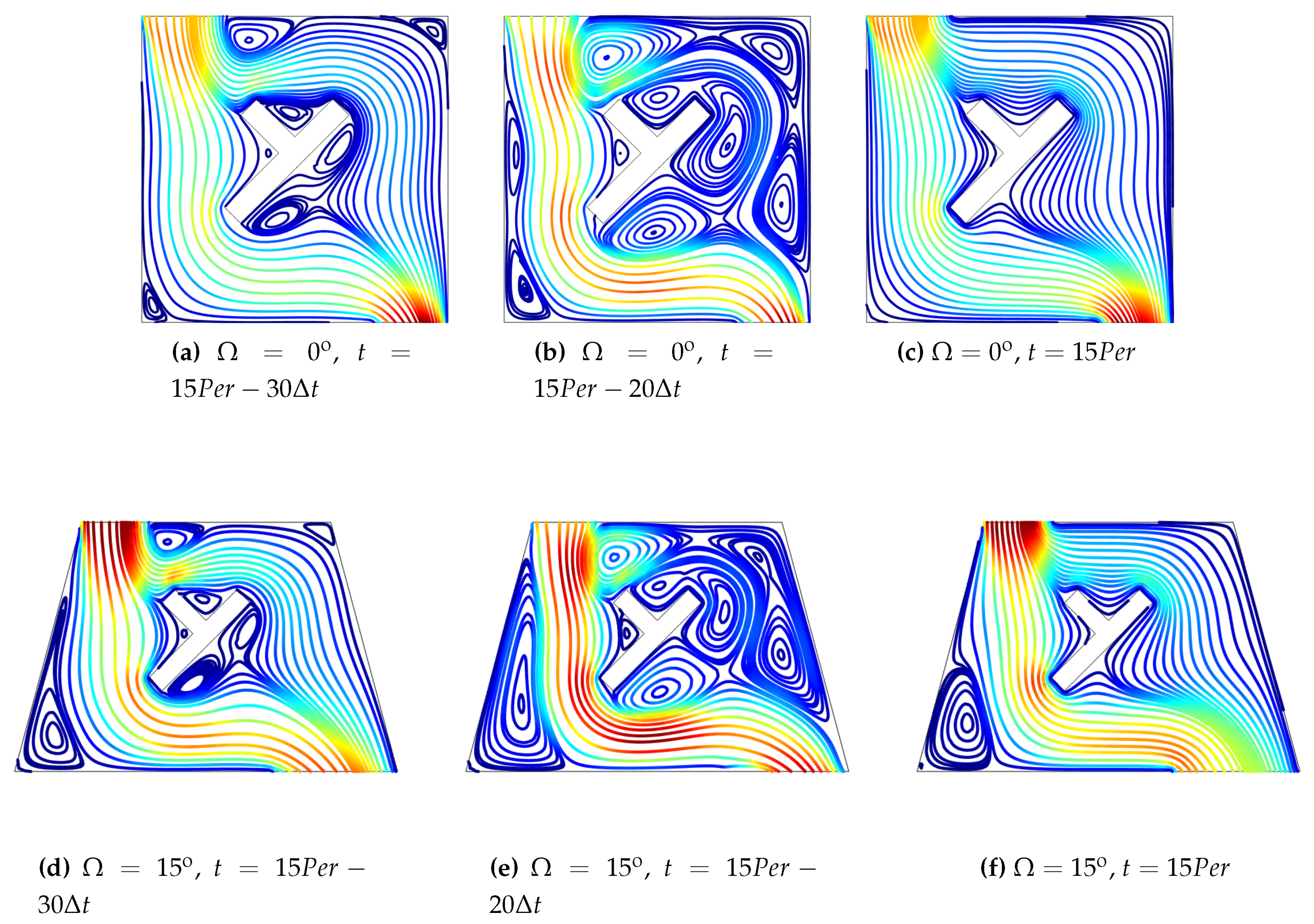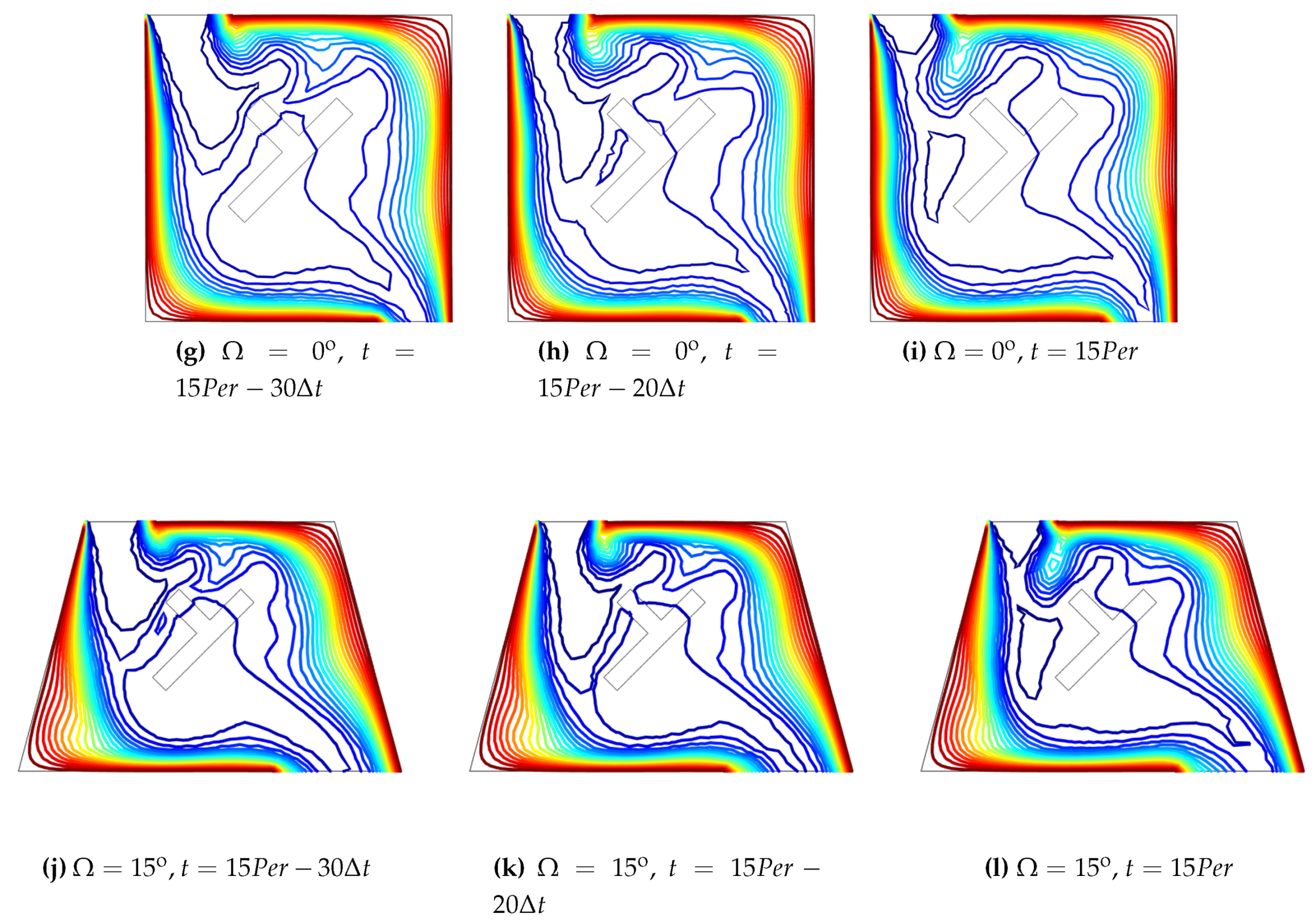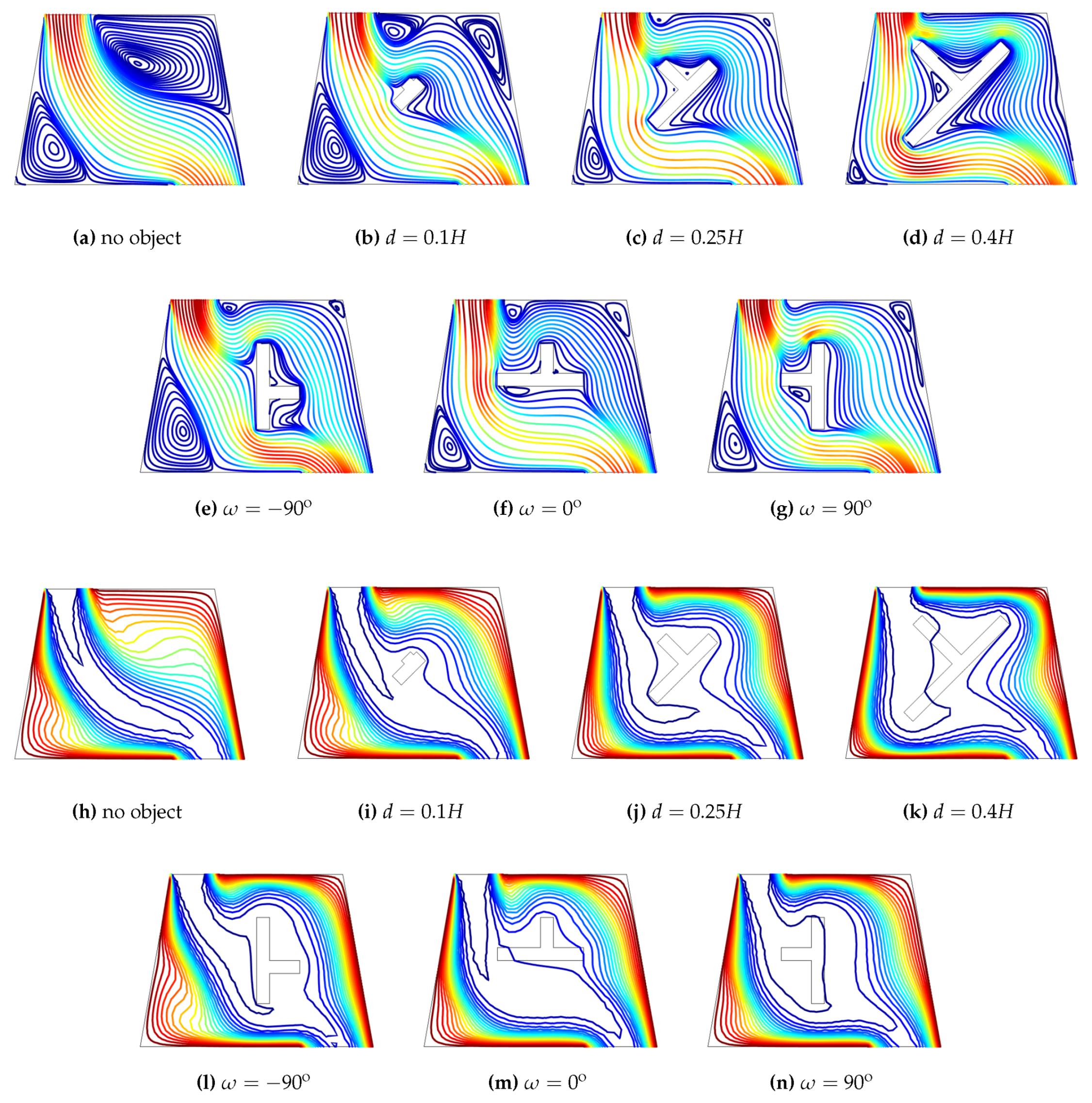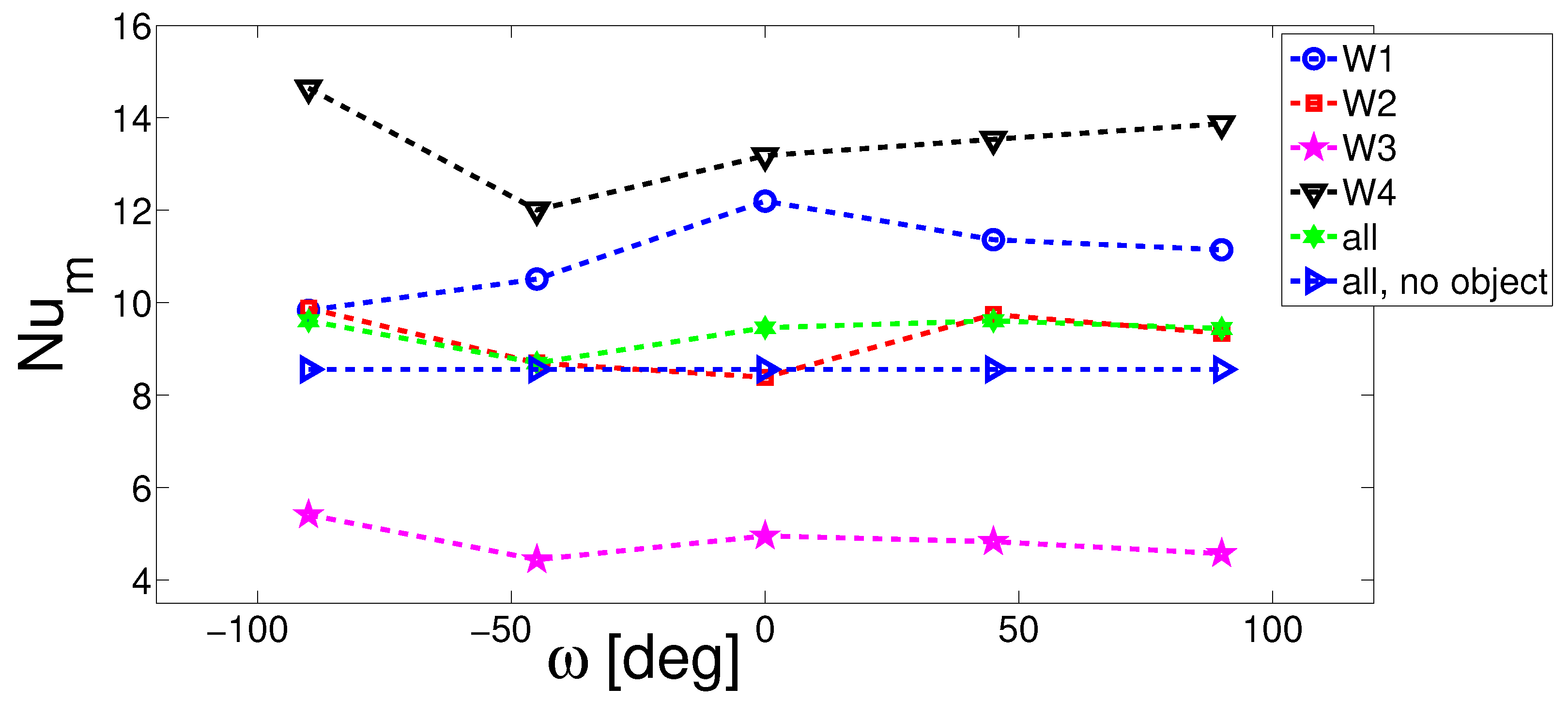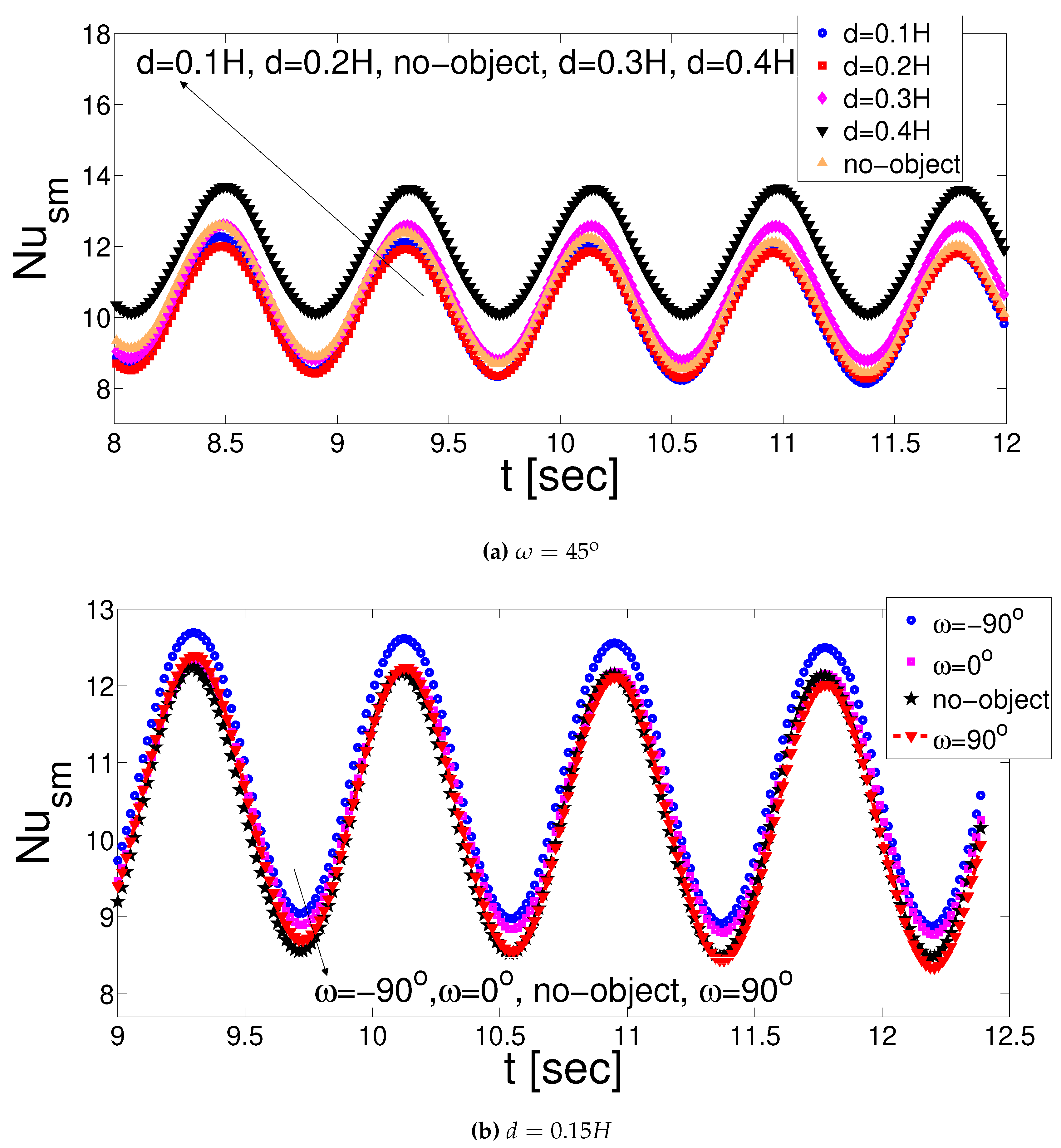Figure 1.
Schematic representation of computational model (not to scale) (a) and grid distribution (b).
Figure 1.
Schematic representation of computational model (not to scale) (a) and grid distribution (b).
Figure 2.
Comparisons of average Nu variation with respect to changes in Reynolds number (a) and differences between the comparisons (b) for mixed convection in cavity at Richardson number of 10.
Figure 2.
Comparisons of average Nu variation with respect to changes in Reynolds number (a) and differences between the comparisons (b) for mixed convection in cavity at Richardson number of 10.
Figure 3.
Effects of Richardson number on the distribution of streamlines (a–c) and isotherms (d–f) (Ha = 20, = 45, 45, ).
Figure 3.
Effects of Richardson number on the distribution of streamlines (a–c) and isotherms (d–f) (Ha = 20, = 45, 45, ).
Figure 4.
Average Nusselt number variations with respect to changes in Richardson number for individual walls (a) and for all walls (b) (Ha = 20, = 45, 45, ).
Figure 4.
Average Nusselt number variations with respect to changes in Richardson number for individual walls (a) and for all walls (b) (Ha = 20, = 45, 45, ).
Figure 5.
Contribution of different hot wall segments to the overall heat transfer rate for various values of Richardson number (Ha = 20, = 45, 45, ).
Figure 5.
Contribution of different hot wall segments to the overall heat transfer rate for various values of Richardson number (Ha = 20, = 45, 45, ).
Figure 6.
Variation of streamlines (a–e) and isotherms (f–j) in the vented cavity for various time instances within a period of the pulsating flow (Ha = 10, = 10, = 45, , , St = 0.5).
Figure 6.
Variation of streamlines (a–e) and isotherms (f–j) in the vented cavity for various time instances within a period of the pulsating flow (Ha = 10, = 10, = 45, , , St = 0.5).
Figure 7.
Spatial averaged Nusselt number (considering all hot walls) variations for three different values of Richardson number (Ha = 10, = 10, = 45, , , St = 0.5).
Figure 7.
Spatial averaged Nusselt number (considering all hot walls) variations for three different values of Richardson number (Ha = 10, = 10, = 45, , , St = 0.5).
Figure 8.
Influence of magnetic field strength on the distributions of streamlines (a–c) and isotherms (d–f) (Ri = 1, = 45, 45, ).
Figure 8.
Influence of magnetic field strength on the distributions of streamlines (a–c) and isotherms (d–f) (Ri = 1, = 45, 45, ).
Figure 9.
Average Nusselt number of the hot wall segments (individual (a) and total (b)) for different Hartmann numbers (Ri = 1, = 45, 45, ).
Figure 9.
Average Nusselt number of the hot wall segments (individual (a) and total (b)) for different Hartmann numbers (Ri = 1, = 45, 45, ).
Figure 10.
Contribution of different hot wall segments to the overall heat transfer rate considering different values of Hartmann numbers (Ri = 1, = 45, 45, ).
Figure 10.
Contribution of different hot wall segments to the overall heat transfer rate considering different values of Hartmann numbers (Ri = 1, = 45, 45, ).
Figure 11.
Variation of streamlines (a–h) and isotherms (i–p) in the vented cavity for various time instances within a period of the pulsating flow and for two values of Hartmann number (Ri = 1, = 10, = 45, , , St = 0.5).
Figure 11.
Variation of streamlines (a–h) and isotherms (i–p) in the vented cavity for various time instances within a period of the pulsating flow and for two values of Hartmann number (Ri = 1, = 10, = 45, , , St = 0.5).
Figure 12.
Impacts of Hartmann number on the variation of spatial averaged Nusselt number considering all hot wall in pulsating flow (Ri = 1, = 10, = 45, , , St = 0.5).
Figure 12.
Impacts of Hartmann number on the variation of spatial averaged Nusselt number considering all hot wall in pulsating flow (Ri = 1, = 10, = 45, , , St = 0.5).
Figure 13.
Impacts of side wall inclination angle of the vented cavity on the variation of streamlines (a–c) and isotherms (d–f) (Ri = 1, Ha = 10, 45, ).
Figure 13.
Impacts of side wall inclination angle of the vented cavity on the variation of streamlines (a–c) and isotherms (d–f) (Ri = 1, Ha = 10, 45, ).
Figure 14.
Effects of cavity side wall inclination angle on the variation of average heat transfer (individual walls (a); and all wall (b)) (Ri = 1, Ha = 10, 45, ).
Figure 14.
Effects of cavity side wall inclination angle on the variation of average heat transfer (individual walls (a); and all wall (b)) (Ri = 1, Ha = 10, 45, ).
Figure 15.
Impact of cavity side wall inclination angle on the contribution of different hot wall segments to the overall heat transfer rate (Ri = 1, Ha = 10, 45, ).
Figure 15.
Impact of cavity side wall inclination angle on the contribution of different hot wall segments to the overall heat transfer rate (Ri = 1, Ha = 10, 45, ).
Figure 16.
Variation of streamlines (a–f) and isotherms (g–l) in the vented cavity for various time instances within a period for two values of side wall inclination angle of the vented cavity (Ri = 1, Ha = 10, , , , St = 0.5).
Figure 16.
Variation of streamlines (a–f) and isotherms (g–l) in the vented cavity for various time instances within a period for two values of side wall inclination angle of the vented cavity (Ri = 1, Ha = 10, , , , St = 0.5).
Figure 17.
Variation of spatial averaged Nusselt number and heat transfer enhancement in pulsating flow for various values of side wall inclination angles (Ri = 1, Ha = 10, , , , St = 0.5).
Figure 17.
Variation of spatial averaged Nusselt number and heat transfer enhancement in pulsating flow for various values of side wall inclination angles (Ri = 1, Ha = 10, , , , St = 0.5).
Figure 18.
Effects of size and orientation of the T-shaped obstacle on the variation of streamlines (b–g) and isotherms (i–n) in the vented cavity (Ri = 1, Ha = 10, = 10). Streamline (a) and isotherm (h) variation in the cavity without object are also shown.
Figure 18.
Effects of size and orientation of the T-shaped obstacle on the variation of streamlines (b–g) and isotherms (i–n) in the vented cavity (Ri = 1, Ha = 10, = 10). Streamline (a) and isotherm (h) variation in the cavity without object are also shown.
Figure 19.
Impacts of size of the T-shaped object on the distribution of the average Nusselt number for individual walls (a) and considering all walls (b) (Ri = 1, Ha = 10, = 10, = 45).
Figure 19.
Impacts of size of the T-shaped object on the distribution of the average Nusselt number for individual walls (a) and considering all walls (b) (Ri = 1, Ha = 10, = 10, = 45).
Figure 20.
Effects of T-shaped object orientation on the variation of the average Nusselt number for individual wall and considering all walls (Ri = 1, Ha = 10, = 10, ).
Figure 20.
Effects of T-shaped object orientation on the variation of the average Nusselt number for individual wall and considering all walls (Ri = 1, Ha = 10, = 10, ).
Figure 21.
Variation of spatial averaged Nusselt number in pulsating flow for various values of size and inclination of the T-shaped object (Ri = 1, Ha = 10, = 10, , St = 0.5).
Figure 21.
Variation of spatial averaged Nusselt number in pulsating flow for various values of size and inclination of the T-shaped object (Ri = 1, Ha = 10, = 10, , St = 0.5).
Figure 22.
Effects of size of the T-shaped object on the average heat transfer and heat transfer enhancement with pulsating flow (Ri = 1, Ha = 10, = 10, = 10, , St = 0.5).
Figure 22.
Effects of size of the T-shaped object on the average heat transfer and heat transfer enhancement with pulsating flow (Ri = 1, Ha = 10, = 10, = 10, , St = 0.5).
Figure 23.
Effects of pulsating flow amplitude (a) and frequency (b) on the variation of spatial averaged Nusselt number considering all hot walls of the vented cavity for various Hartmann numbers (Ri = 1, = 10, = 45, ).
Figure 23.
Effects of pulsating flow amplitude (a) and frequency (b) on the variation of spatial averaged Nusselt number considering all hot walls of the vented cavity for various Hartmann numbers (Ri = 1, = 10, = 45, ).
Figure 24.
Average Nusselt number and heat transfer enhancement with pulsating flow amplitude (a,b) and frequency (c,d) (Ri = 1, = 10, = 45, ).
Figure 24.
Average Nusselt number and heat transfer enhancement with pulsating flow amplitude (a,b) and frequency (c,d) (Ri = 1, = 10, = 45, ).
Table 1.
Grid independence test for various grid sizes: The average Nusselt number comparisons considering all hot walls of the vented cavity for different values of Ri and Ha numbers for different grids while the other values are fixed to = 10, = 45, and .
Table 1.
Grid independence test for various grid sizes: The average Nusselt number comparisons considering all hot walls of the vented cavity for different values of Ri and Ha numbers for different grids while the other values are fixed to = 10, = 45, and .
| Ri | Ha | Grid Type (Number of Elements) |
|---|
| | | G1 (1433) | G2 (3038) | G3 (6127) | G4 (12814) | G5 (49897) |
| 0.05 | 0 | 57.903 | 40.886 | 26.237 | 23.713 | 23.522 |
| 0.05 | 10 | 57.649 | 40.667 | 25.866 | 23.369 | 23.196 |
| 0.05 | 30 | 57.368 | 40.868 | 25.671 | 23.489 | 23.371 |
| 50 | 0 | 4.078 | 4.054 | 3.974 | 4.020 | 4.041 |
| 50 | 10 | 3.966 | 3.934 | 3.827 | 3.876 | 3.898 |
| 50 | 30 | 4.176 | 4.138 | 4.028 | 4.101 | 4.124 |
Table 2.
Average Nusselt number comparisons calculated with the present solver and obtained by Ghasemi et al. [
65] for convection in cavity considering magnetic field effects for various Rayleigh numbers while the Hartmann number is fixed to 30.
Table 2.
Average Nusselt number comparisons calculated with the present solver and obtained by Ghasemi et al. [
65] for convection in cavity considering magnetic field effects for various Rayleigh numbers while the Hartmann number is fixed to 30.
| Ra | Current Study | Ref. [65] |
|---|
| 10 | 1.179 | 1.183 |
| 10 | 7.869 | 7.907 |
| 10 | 16.702 | 16.929 |
Table 3.
Heat transfer enhancement with pulsating flow for different values of Richardson numbers (Ha = 10, = 10, = 45, , , St = 0.5).
Table 3.
Heat transfer enhancement with pulsating flow for different values of Richardson numbers (Ha = 10, = 10, = 45, , , St = 0.5).
| Ri |
Steady (Average Nu)
|
Pulsating (Highest Value of Space Average Nu)
| HTE |
|---|
| 0.1 | 19.93 | 29.20 | 46.51 |
| 1 | 9.61 | 10.95 | 13.94 |
| 10 | 5.51 | 6.97 | 26.49 |
Table 4.
Heat transfer enhancement with pulsating flow for various values of Hartmann number (Ri = 1, = 10, = 45, , , St = 0.5).
Table 4.
Heat transfer enhancement with pulsating flow for various values of Hartmann number (Ri = 1, = 10, = 45, , , St = 0.5).
| Ha |
Steady (Average Nu)
|
Pulsating (Highest Value of Space Average Nu
| HTE |
|---|
| 0 | 9.56 | 12.48 | 30.54 |
| 10 | 9.61 | 12.23 | 27.26 |
| 30 | 10.66 | 12.70 | 19.13 |
Table 5.
Heat transfer enhancement in pulsating flow with various values of orientation of the T-shaped object in the vented cavity (Ri = 1, Ha = 10, = 10, , , St = 0.5).
Table 5.
Heat transfer enhancement in pulsating flow with various values of orientation of the T-shaped object in the vented cavity (Ri = 1, Ha = 10, = 10, , , St = 0.5).
| (deg) |
Steady (Average Nu)
|
Pulsating (Highest Value of Space Average Nu)
| HTE |
|---|
| −90 | 9.61 | 12.62 | 31.32 |
| 0 | 9.46 | 12.23 | 29.28 |
| 90 | 9.44 | 12.18 | 29.02 |
Table 6.
Heat transfer enhancement with CNT nanoparticles (Ha = 10, = 10, = 45, , , St = 0.5).
Table 6.
Heat transfer enhancement with CNT nanoparticles (Ha = 10, = 10, = 45, , , St = 0.5).
| | | Ha = 0 | |
| Steady (Average Nu) | Pulsating (Highest Value of Space Average Nu) | HTE |
| 0 | 8.55 | 6.42 | 33.17 |
| 0.01 | 10.25 | 7.91 | 29.58 |
| 0.02 | 12.30 | 9.57 | 28.52 |
| 0.03 | 14.58 | 11.37 | 28.23 |
| 0.04 | 16.90 | 13.33 | 26.78 |
| | | Ha = 30 | |
|---|
| Steady (Average Nu) | Pulsating (Highest Value of Space Average Nu) | HTE |
| 0 | 8.55 | 7.19 | 18.54 |
| 0.01 | 10.60 | 8.84 | 19.89 |
| 0.02 | 12.70 | 10.66 | 19.14 |
| 0.03 | 14.96 | 12.63 | 18.44 |
| 0.04 | 17.41 | 14.77 | 17.87 |
